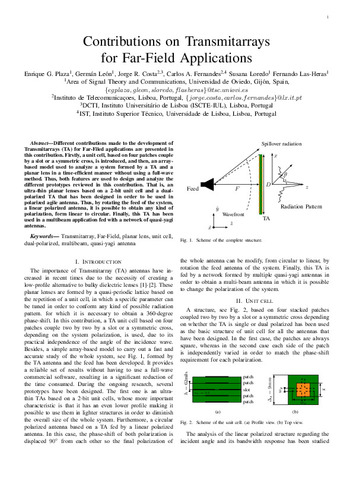Contributions on Transmitarrays for Far-Field Applications
Palabra(s) clave:
Transmitarray antennas
Fecha de publicación:
Resumen:
Different contributions made to the development of Transmitarrays (TA) for Far-Filed applications are presented in this contribution. Firstly, a unit cell, based on four patches coupled by a slot or a symmetric cross, is introduced, and then, an arraybased model used to analyze a system formed by a TA and a planar lens in a time-efficient manner without using a full-wave method. Thus, both features are used to design and analyze the different prototypes reviewed in this contribution. That is, an ultra-thin planar lenses based on a 2-bit unit cell and a dualpolarized TA that has been designed in order to be used in polarized agile antenna. Thus, by rotating the feed of the system, a linear polarized antenna, it is possible to obtain any kind of polarization, form linear to circular. Finally, this TA has been used in a multibeam application fed with a network of quasi-yagi antennas
Different contributions made to the development of Transmitarrays (TA) for Far-Filed applications are presented in this contribution. Firstly, a unit cell, based on four patches coupled by a slot or a symmetric cross, is introduced, and then, an arraybased model used to analyze a system formed by a TA and a planar lens in a time-efficient manner without using a full-wave method. Thus, both features are used to design and analyze the different prototypes reviewed in this contribution. That is, an ultra-thin planar lenses based on a 2-bit unit cell and a dualpolarized TA that has been designed in order to be used in polarized agile antenna. Thus, by rotating the feed of the system, a linear polarized antenna, it is possible to obtain any kind of polarization, form linear to circular. Finally, this TA has been used in a multibeam application fed with a network of quasi-yagi antennas
Descripción:
XI Encuentro Ibérico de Electromagnetismo Computacional-IIEC, 8-11 de noviembre de 2016, Asturias (España)
Patrocinado por:
Project MIRIIEM with ref. TEC2014-540005-P of the Ministerio de Econom´ıa y Competitividad, and the research project of the Gobierno del Principado de Asturias / FEDER with ref. GRUPIN14-114
Colecciones
Ficheros en el ítem





